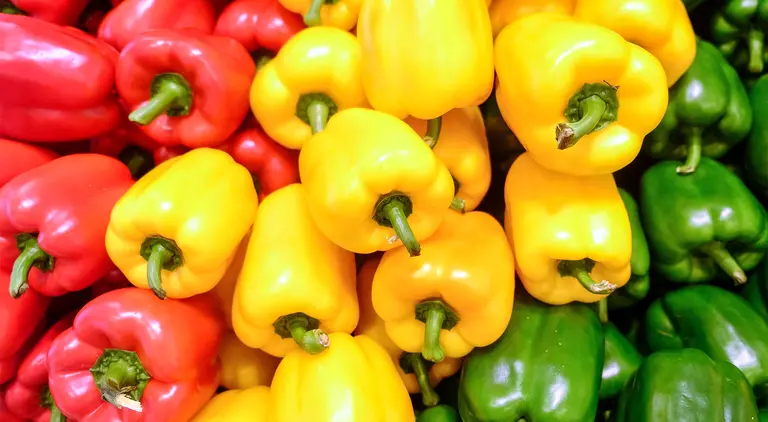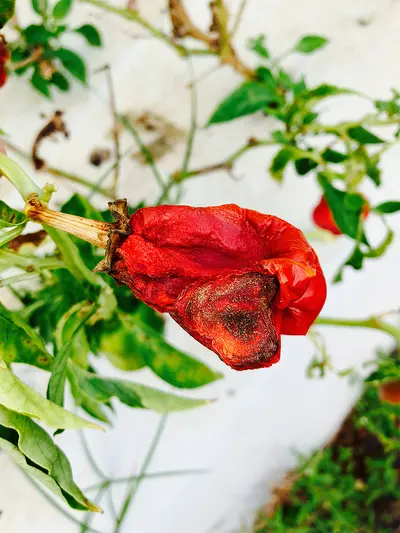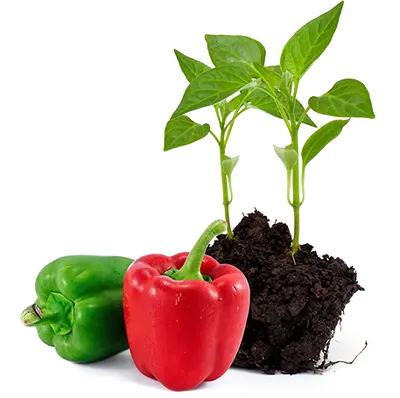Veggies - Bell peppers "special Bacterial Spot disease"
Study Investigator: J. Curtis, Phd
Location of Study: Florida, USA, open field
Study Period: May- July 2018
VEGRO® incorporated into treatments: [T3],[T4],[T5]
DAP: Number of Days After Precedent application
App 1
1 Pt/Acre from 1st flowers, (GS+Vegro®)
App 2
1 Pt/acre, 7 DAP
App 3
1 Pt/acre, 7 DAP
App 4
1 Pt/acre 7 DAP
App 5
1 Pt/Acre, 7 DAP
App 6
1 Pt/Acre, 7 DAP
App 7
1 Pt/Acre, 7 DAP
TREATMENTS
Plants were maintained at a commercial level with insecticide (twice weekly applications of BT) as well as fertilizer (6-0-6 liquid fertilizer through the drip every other day at the rate of 25 Gals/Acre). No fungicides were applied priorly this trial.
Applied: A,B,C,D,E,F,G and replicated 4 times
............................................
Treatment [T1]: Grower Std - no fungicides
Applied: A,B,C,D,E,F,G and replicated 4 times
- • Grow. Std. but no fungicides
............................................
Treatment [T2]: Grower Std: + fungicides
Applied: A,B,C,D,E,F,G and replicated 4 times
- • Grower Std.
- • Manzate max @ 2 Qts/Acre
- • Kocide 2000 @ 3lb/Acre
- • Bravo Weatherstick @ 1.5 Pt/Acre
............................................
Treatment [T3]: Grow. Std. - No fungicides + Vegro
Applied: A,B,C,D,E,F,G and replicated 4 times
- • Grow. Std. - No fungicides
- • Vegro @ 1 Pt per acre
...........................................
Treatment [T4]: Grow. Std. + fungicides + Vegro
Applied: A,B,C,D,E,F,G and replicated 4 times
- • Grow. Std.
- • Vegro @ 1 Pt/Acre
- • Manzate max @ 2 Qts/Acre
- • Kocide 2000 @ 3lb/Acre
- • Bravo Weatherstick @ 1.5 Pt/Acre
............................................
Treatment [T5]: Grow. Std. + fungicides + Vegro + Phosphacid
Applied: A,B,C,D,E,F,G and replicated 4 times
- • Grower standard
- • Vegro @ 1 Pt/Acre
- • Manzate max @ 2 Qts/Acre
- • Kocide 2000 @ 3lb/Acre
- • Bravo Weatherstick @ 1.5 Pt/Acre
- • 0-28-26 @ 2 Qt/Acre
•••••••••••••••••••••••••••••••••
APPLICATIONS
• Foliar Applications (Apps. A-G; Trts. 2-5).
• 7 (seven) total as: A,B,C,D,E,F,G
• Foliar applications were made on: 5/17/2018 (App. A), 5/24/2018 (App. B), 5/31/2018 (App. C), 6/7/2018 (App. D), 6/14/2018 (App. E), 6/21/2018 (App. F) and 6/28/2018 (App. G).
• These foliar applications were made with a hand-held boom (CO2 operated, 40 PSI) fitted with three nozzles
•••••••••••••••••••••••••••••••••
EVALUATIONS:
BACTERIAL SPOT SEVERITY (%)
The percentage (%) severity of bacterial spot (0 = no symptoms…..100% = dead plants) was evaluated on 60 plants (1 row side) of each plot on 6/7/2018, 6/14/2018, 6/21/2018 and 6/28/2018.
•••••••••••••••••••••••••••••••••
FRUIT COUNT & WEIGHT (lb)
All fruit in each plot were harvested on 7/2/2018 and counted and weighed (lb).
•••••••••••••••••••••••••••••••••••••••••••••••••••••••••••••••••••••••••••••••••••
FRUIT GRADING & MARKETABILITY
All harvested fruit were graded into six (6) categories and based on size using USDA guidelines (1 1/9 bu.box, 20 to 30 lb):
• Jumbo - 3 3/4 inch diam., 3 1/2inch length (45 count and fewer).
• Extra Large - 3 1/2 inch diam, 3 1/2 inch length (46-55 count).
• Large - 3 1/4 inch diam., 3 inch length (56-70 count).
• Medium - 3 inch diam., 3 inch diam., 2 1/2 inch length (71-85 count).
• Small - 2 1/2 inch diam., 2 inch length (86-110 count).
• Trash
The percentage (%) of fruit in each of the six categories was then calculated.
It is important to note that the USDA recommendations for sizing are a guideline and there are variations of grading amongst growers. For example, pepper may be graded as follows:
• Jumbo - 3 1/2 inch diam. and larger.
• Extra Large - 3 inch diam., 3 1/2 inch length.
• Large -2 1/2 inch diam.,3 inch length.
• Medium- 2 inch diam., 2 1/2 inch length.
•••••••••••••••••••••••••••••••••••••••••••••••••••••••••••••••••••••••••••••••••••
METHODOLOGY
FIELD AND PLANTING
• This trial was conducted in open field at the Better Crops Research Farm: Block 11, Section N, Beds 1-7.
• Each plot was 30 ft in length x 2 beds (30 ft length x 12 ft width).
• Each plot had 120 plants and each treatment was replicated four (4) times.
• Treatments were arranged in Beds 2, 3, 5 and 6.
• These treatment beds were separated by an untreated buffer rowsin Beds 1, 4 and 7.
• Plastic beds (32 inch top, 6 inch tall) were prepared on a 6 ft row spacing.
• Bell pepper (cv. revolution) were transplanted in two row/bed (12 inch plant spacing) on 4/19/2018.
• Plants were maintained at a commercial level with both fungicide (twice weekly applications), insecticide (VYDATE and BT) and fertilzer (liquid fertilizer through the drip every other day).
Study Results
+58%
Total fruit count / VEGRO [T5]
+43%
More fruit weight / VEGRO [T5]
-45%
Bact. Spot reduction from [T2] to [T5] with VEGRO
+22%
VEGRO improves the efficacy of the fungicides
X 2
Packout ratio of [T5] VEGRO Vs [T2] NO Vegro
X 8
More JUMBO's in [T5] VEGRO Vs [T2] NO Vegro
+42%
More XL sizes in [T5] VEGRO Vs [T2] NO Vegro
+23%
More L sizes in [T5] VEGRO Vs [T2] NO Vegro
72%
Less Waste between [T5] VEGRO Vs [T2] NO Vegro
0%
Vegro® is zero Phytotoxicity
Objectives: To demonstrate the capacity of Vegro® to improve the efficacy of the fungicides at helping to reduce the Bacterial spots on Pepper and to help at reducing the chemical residues. Main parameters monitored for this study: Pressure disease (severity); Yield (weight & fruit counts) and fruit size distribution.
For a better view of the graphs and charts, reposition your mobile device into landscape mode.
RESULTS ON BACTERIAL SPOTS DISEASE
How Vegro® helps to improve the efficacy of the fungicides against the Bacterial spots disease on Bell peppers.
- 70% and 52% are the degree of severity of the bacterial spots into the treatments 2 and 5.
- 18% is the difference between the two treatments.
- VEGRO® is indeed improving the efficacy of the fungicides by +18% on Bacterial Spots.
- The severity of the Bacterial spots in [T1], with no fungicides at all is: 77%, whereas VEGRO® by itself in no combination with any fungicides in [T3] is 64%.
- It is also noticeable to see that [T1] no fungicides, compared to [T5] Fungicides + VEGRO® gives a siginificant reduction of the disease by 25%.
- VEGRO® has indeed an icidence on helping to control the Black Spot disease.
- VEGRO® improves the efficacy of the fungicides.
![[T1] is the Grower Std., [T3] Vegro added simply to Grow. Std. and [T5] Grow Std + Fungicides + Vegro](/assets/components/phpthumbof/cache/Bact-spot-12.6a8a2494464a79d7488994d6e732abfd.webp)
ALL RESULTS BY TREATMENT OBTAINED ON BACTERIAL SPOTS
Higher are the bars, worst is the infection on Bacterial Spots,
• Brown colors NO VEGRO®.
• Green colors WITH VEGRO®
Results expressed in % and by degree of severity.
Rate of Bacterial Spots severity in % and at the ultimate harvest (H4):
- Results: [T1] 77%; [T2] 70%; [T3] 64%; [T4] 63%; [T5] 52%
- 25% when Vegro is combined with fungicides [T5] Vs [T1]
- 13% When Vegro stand on its own (no fungicides added, on top of the Ctrl)
- 14% Bacterial spots when using [T4] Vs [T1]
- 1% difference of efficacy between [T4] and [T3]
VEGRO® HELPS TO PRODUCE QUALITY FRUITS
Here the results by count numbers:
- VEGRO® helps to produce more yield.
![[T1] Ctrl, [T3] Vegro with no fungicides and [T5] Vegro+Fungicides](/assets/components/phpthumbof/cache/Pepper-count-number-.6a8a2494464a79d7488994d6e732abfd.webp)
VEGRO® HELPS TO PRODUCE QUALITY FRUITS
Here the results by weight:
- VEGRO® helps to produce more quality yield.
- VEGRO® doesn't help only to improve the numbers but in combination of the fungicides and phosphacid it does improve as well the quality by improving sizes and density of the fruit.
- Brings higher value to the production
![[T1] Ctrl, [T3] Vegro with no fungicides and [T5] Vegro+Fungicides](/assets/components/phpthumbof/cache/Pepper-weight-graph.6a8a2494464a79d7488994d6e732abfd.webp)
RESULTS ON FRUIT SIZE DISTRIBUTION
RESULTS as per graph below:
- [T1] 0% jumbo's, 7.4% XL, 19.9% L, 21% M, 33.6% S and 18% Trash
- [T2] 3% jumbo's, 19.4% XL, 26% L, 27% M, 18% S and 6.5% Trash
- [T3] 10% jumbo's, 28% XL, 30% L, 16% M, 12% S and 4.8% Trash
- [T4] 10% jumbo's, 19% XL, 31.6% L, 20% M, 16% S and 3.4% Trash
- [T5] 10% jumbo's, 27% XL, 31% L, 19% M, 11% S and 1.8% Trash
Side notes:
- [T3]; [T4]; [T5] do contain VEGRO® and it is very striking that Jumbo's are 10% in each of these whereas it is zero in [T1] and 2.0 in [T2].
- [T3] is the treatment without any fungicides but with VEGRO® and it shows a very clear and significant advantage in obtaining larger sizes.
- [T3] is; 10% Jumbo's, 28% XL and 30% L
Fruit grade considered for this trial: Jumbo - 3 3/4 inch diam., 3 1/2inch length (45 count and fewer), Extra Large - 3 1/2 inch diam, 3 1/2 inch length (46-55 count), Large - 3 1/4 inch diam., 3 inch length (56-70 count), Medium - 3 inch diam., 3 inch diam., 2 1/2 inch length (71-85 count), Small - 2 1/2 inch diam., 2 inch length (86-110 count), Trash. It is important to note that USDA fruit size grade is less restrictive (Ref here on grey zone at fruit grading)
MAIN FACTS ON FRUIT SIZE DISTRIBUTION
By order:
- • [T1] Control no fungicides, First line
- • [T3] Ctrl + Vegro® + NO Fungicides, second line
- • [T5] Ctrl + Vegro® + Fungicides, third line
![[T1] is the Grower Std., [T3] Vegro added simply to Grow. Std. and [T5] Grow Std + Fungicides + Vegro](/assets/components/phpthumbof/cache/fruit%20size%20distri%20pepper%20bact%20spot.6a8a2494464a79d7488994d6e732abfd.webp)
MARKETABILITY AND PACKOUT
Here under the most marketable sizes from Jumbo's, XL, L and M by main treatments:
- 48% is the addition of the sizes comprised between Jumbo's to Medium [T1] Ctrl with no fungicides.
- 83% for [T3] Vegro + No fungicides.
- 87% for [T5] Vegro + fungicides.
87%
Best Packout ratio
[T5] Vegro + Fungicides
WASTE AND LOW VALUE
If by treatment we add, small and trash together, we obtain:
- [T5] 12.5%; [T4] 19.4%; [T3] 16.8%; [T2] 24.5%; [T1] 51.6%
13%
[T5] Best
Less waste
The correlation between unit and weight count and now with the fruit size, it brings the benefits to another level here. Best treatment is [T5] Vegro+fungicides, followed very closely by [T3] Vegro® with NO Fungicides.





